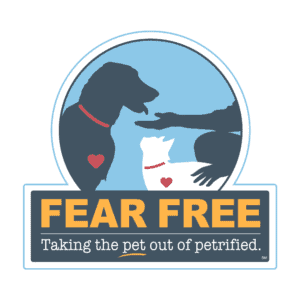How to Best Transport your Dog to the Vet
Dr. Bridget Andersen
How you transport your dog to the vet matters. We at Animal Medical Hospital are working to become a certified “Fear Free” hospital. The term “Fear Free” refers to a movement within veterinary medicine that addresses the emotional welfare of our patients, and the people that love them. This means that we are making adjustments to our lobby, exam room visits, and hospitalized stays in order to decrease fear, anxiety, and stress. The first step to a less stressful visit to the veterinarian starts with a positive traveling experience.
-
Prepare the car
- Play calming music or music specifically made to soothe dogs (Through a Dog’s Ear, or Icalm).
- Make sure that your dog has secure footing in the car. Use a non-slip mat.
- Fasten in your dog with a seatbelt or place inside a carrier to provide your pet with a secure place to rest and to prevent injury or loss during the event of an accident.
-
Use pheromones
Dog appeasing pheromones such as Adaptil can have a calming effect on your dog. Pheromones can be purchased as a spray, collar, or wipe and can be sprayed in your car or to a bandana that your dog can wear around his/her neck.
-
Praise
- Praise your dog for calm behavior. Bring his or her favorite treats and use them in the car, lobby and the appointment.
- Avoid disciplining your dog for showing signs of stress such as barking, growling, hiding, or refusing to walk.
-
Safety
- Make sure your dog is always on a leash or is in a carrier. Your pet’s behavior may be unpredictable at the veterinary office and leashes and carriers can prevent tragic loss and injury.
- In addition, maintaining control over your pet will also enable you to more quickly protect your dog from another dog in the event of an altercation.
-
Sedation
- Your dog may need an anti-anxiety medication prior to coming into the hospital. If he/she starts to show signs of fear, anxiety and stress (panting, drooling, pacing, barking) as soon as they get into the car, please call AMH to discuss premedication.
- A stressful car ride will never lead to a good vet visit.
-
Reschedule
Consider rescheduling your appointment if your dog is showing signs of fear, anxiety or stress (see chart below).
-
Return home
- If your dog is returning to a multi-dog household, be aware that the housemates that remained at home may not be accepting of the dog that is returning to the house due to the strange hospital smells.
- Monitor all dogs carefully after returning until your are sure that they are accepting one another.
- If they seem on edge, separate the dog who went on the vet visit and rub him/her down with a garment or towel that has a familiar “home” smell.
- For dogs that have been sedated, keep them in a quiet room by themselves until they are completely awake.
-
Don’t hesitate to call for advice if you are having difficulty transporting your dog! 704-334-4684


